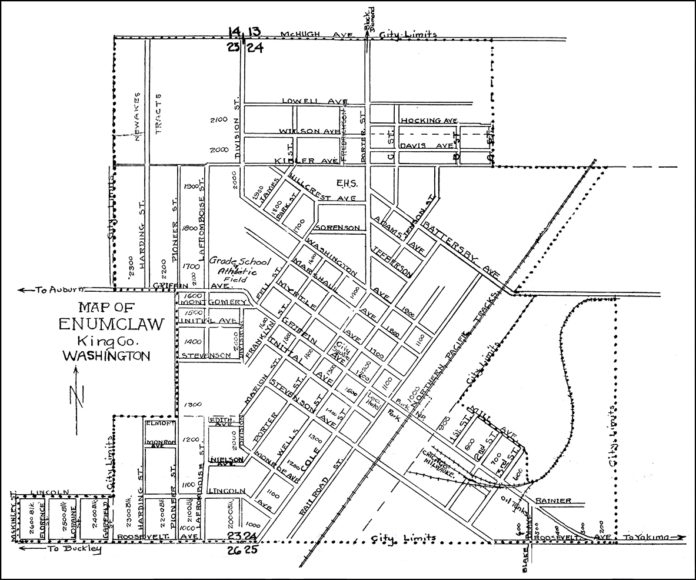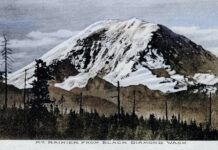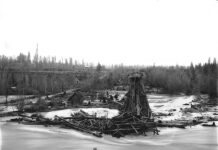When Frank and Mary (Fell) Stevenson acquired their homestead in 1879, they had no idea the Northern Pacific Railroad would soon build the missing 77-mile rail link connecting Yakima to Tacoma and propose a rail station on their land. Early settlers wanted to call the budding town Stevensonville, but Frank and Mary modestly refused the honor. Marion Montgomery Lee, the wife of railroad engineer, Charley Lee suggested Enumclaw, the name local Native Americans called a nearby sawed-off promontory north of town. Enumclaw means ‘thundering noise” from a story told by an Indian named Peter who related how a band of warriors heard the rattling sounds that seemed to come from the mountain’s interior.
Enumclaw prospered and grew into a bustling town as seen in this 1937 map featuring a grid of streets and avenues which first developed parallel to the railroad tracks, but soon followed the Township system of square 640-acre sections of land featuring a true north-south-east-west axis. In 1941, the Women’s Progressive Club published “The Pioneer History of Enumclaw,” which included a chapter on how the early streets came to be named.
Ten streets were named for U.S. Presidents: George Washington Avenue; John & John Quincy Adams Avenue; Thomas Jefferson Avenue; James Monroe Avenue; Abraham Lincoln Avenue; James Garfield Street; William McKinley Street; Theodore Roosevelt Avenue; Woodrow Wilson Avenue; and Warren Harding Street. Interestingly, Harding was originally named French Street to honor the many French families who homesteaded the Fir Grove area west of Osceola. In fact, in a few places, French Street can still be seen stamped in the sidewalk cement.
Battersby Avenue is believed to be named for R.H. Battersby, an elected road supervisor who improved roads towards Krain. Blake Street was named after John Blake and Cedar Street for a grove of nearby cedar trees. Cole Street was originally spelled Coal Street, and so named because it ran out towards Coal Creek in Veazie. Town leaders thought naming a street called Coal might generate commercial goodwill from the mining centers of Black Diamond, Franklin, Carbonado, and Wilkeson.
Davis Avenue. was named after J.W. Davis. Division Street marked the dividing line between Sections 23 to the west and Stevenson’s Section 24. Division Street followed the Township system, while streets on Stevenson’s land were built parallel to the railroad. Edith Avenue was named after Mrs. Edith Jensen, wife of Rasmus Jensen. Elmont Street was named for Elmont Poh, while Joseph Fell Sr., father of Mary Stevenson was honored with Fell Street. Florence Street was named after a niece of Mrs. Olaf M. Berg.
Franklin Street was named for Frank Stevenson, while Fredrickson Street honored the Frederickson family. Arthur E. Griffin was Enumclaw’s first Postmaster and the namesake of Griffin Avenue. Hillcrest Avenue, the site of the former high school and junior high torn down in 1985 was at the crest of a hill. Hocking Avenue was named for Bessie Hocking Moore.
Initial Avenue was a beginning point for early avenues along the railroad grid, while James Street was for James Montgomery Sr. Jensen Street was named for Danish businessmen, Paul and J.C. Jensen. Kibler Avenue was christened after Byron R. Kibler, the town’s first lawyer and founding partner of People’s State Bank. Kibler Avenue marks the starting line for the Township grid to the north as Division Street does to the west. Lafromboise Street was designated for the Lafromboise family. Loraine Street was dubbed for Lorraine Berg, daughter of Thilda and N.M. Berg.
At the request of Byron Kibler, Lowell Avenue was named to honor the 19th century fireside poet, James Russell Lowell. Marion Street was christened for Mrs. Marion, wife of Ivan P. Lee, an electrician. Marshall Avenue was named in honor of Serena B. Marshall, a teacher who later became Mrs. Serena B. Sachs, of Elbe, Washington. McHugh Street was named for Basil M. McHugh, the City Engineer from 1920-1935 who wrote the chapter detailing the origins of Enumclaw’s street names, from which this history is adapted.
Mill Avenue gained its designation because it fronted the site of the lumber mill, early on one of Enumclaw’s biggest employers. Montgomery Avenue honored the entire Montgomery family, while Myrtle Avenue was named for Myrtle Lee Holloway, sister of Ivan P. Lee. Nielsen Avenue was chosen for Hans Nielsen, who with Rasmus Jensen platted the Kielsen Jensen Addition. In the early days, there was a fir grove and picnic area that boarded Park Street, hence the designation. Pioneer Street honored all the original Enumclaw pioneers.
In 1850 at age 19,Allen L. Porter traveled west on the Oregon Trail. Three years later, Porter filed a claim for 320 acres that became known as Porter’s Prairie, and today is part of Osceola. ‘Old Man Porter’ remained there for decades and even though he lived west of town, Porter Street was the name for the road to Black Diamond. Railroad Street fronted the west side of the railroad, while First, Second, and Third Streets were consecutively numbered east of the Northern Pacific line. Second Street was later renamed Garrett Street in honor of Dwight Garrett, owner of the company that invented tree skidders for logging.
Mount Rainier was known to Native Americans as Takhoma, Taquoma, or Tacoma and gave Rainier Avenue its name. Sorenson Avenue honors S.L. Sorenson, the traveling salesman of Danish stock who became the face of Farmer’s Mutual Insurance Co. In 1966, the company’s name was changed to Mutual of Enumclaw. It is still one of the town’s top employers. Stevenson Avenue recognizes Frank and Mary Stevenson, Enumclaw’s founders. The flats down by the railroad were swampy and unsuitable sites for the town’s first drinking wells located on Wells Street,three blocks west.
Enumclaw has expanded considerably since 1941 when the Women’s Progressive Club undertook the effort to record memories of a dying generation of pioneers, thereby preserving for us this precious history of how our early streets gained their name.







